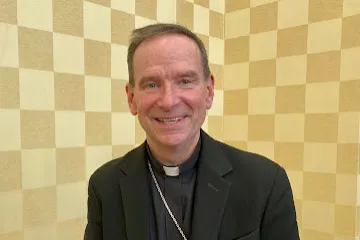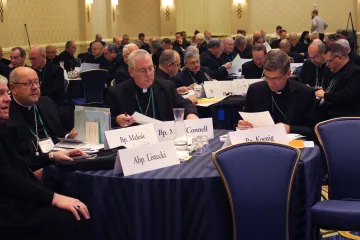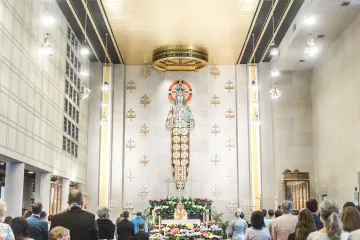Baltimore, Md., Nov 20, 2022 / 12:00 pm
Archbishop Salvatore J. Cordileone of San Francisco sat down with CNA for an interview during a break in the proceedings of the U.S. bishops’ fall meeting in Baltimore last week.
Cordileone, a staunch advocate for the unborn, spoke out against Proposition 1, a ballot initiative to add the “right to abortion” to California’s constitution, which received over 66% of the vote in the 2022 midterm elections. One week later, the archbishop shared his thoughts on what is next for the pro-life movement, his hopes for the bishops’ eucharistic revival initiative, and how to address a lack of trust that priests have for their bishops. This interview was edited for length and clarity.
The pro-life movement suffered a defeat in California with the passage of Proposition 1. What advice do you have for opponents of abortion in this post-Dobbs political climate?
We have to keep doing what we have been doing. I think the key is this Walking with Moms in Need [the U.S. bishops’ nationwide initiative to assist pregnant and parenting women]. We have to continue holding up what is real compassion for a woman in that situation, who’s scared, isolated, full of anxiety, under all kinds of pressure, and feeling lonely. She needs to be surrounded with love and support.
The answer is not violence. The answer is not killing. The answer is love and support. And we need to hold up, and I would hope — but I see a growing resistance to it — that even those who favor keeping abortion legal would favor giving women the full range of options. If she’s given information about what’s going on inside of her, if she’s given information about what her options are, and is given love and support and we walk with her, she will opt for life. I know this from crisis pregnancy clinics, that when they’re given that information, and they’re given love and support, 95% opt for life. So what we really need is for women to have real choice.
Unfortunately, women who are in the lower income [brackets] don’t really have choice. So we need to give them real choice. I think that’s the way we build the culture of life. Laws are important, and political advocacy is important. Our pro-life manifestations are important to help raise consciousness about it. But in a bitterly polarized society, we need to support the women in these situations and show where true love and compassion is.
That’s why I’m horrified at the hostility toward crisis pregnancy clinics. That’s all about love and support, and even beyond the birth of the child, making sure she and her baby are OK. This is the most worrying sign to me — the attacks on the crisis pregnancy clinics. And our leaders are not speaking out against it and being active in protecting them, and in fact, are denigrating them.
Considering how Proposition 1 succeeded, how can you move the needle on this issue? Do you put more money into Walking with Mothers in Need? Or do you put your efforts into doing a better job on communications?
Well, it’s all of the above. That’s a good question, “Where do we put the emphasis?” We do need better communication about it. Because we’re up against a lot with that, especially with the false narratives that are being perpetrated about these clinics. And I think the best thing is for women to tell their stories, women who have gone through this experience. We need women to tell their stories and let it get out there because it’s the personal story that touches hearts. And that’s what begins to change the conversation.
How do you reach young women who support abortion because they think it may be necessary for their personal success?
Yes. I think they need to be walked with, as well. Why would it get in the way of their career or their education? Why can’t she continue with her education, or begin her career and bring the baby to term, and if she wants to, put the child up for adoption? We need to emphasize adoption a lot more. Are universities prepared to support their women students in giving birth? Are the health care services offered? Do they have that prenatal care available? What if she has to absent herself from class? Can she do online instruction during the time she has to be away? Even something as simple as diaper-changing stations? So do they have all of that? And if not, then where’s the equality? The man doesn’t have to worry about that. We can just walk away and continue, but the woman can’t. She’s facing very hard choices. Why aren’t they giving her the support? Where’s the equality in that?
In your view, what is the most troubling issue of our day?
The most urgent crisis today is the attack on life in the womb, and the lack of support for women who are in need to be able to make a choice for life. I’d say, the celebration of abortion as a good. You know, it was originally something that people said was a necessary evil, then it became a choice. And then it became health care. Now they’re calling it reproductive freedom, which can mean all kinds of things. And now it’s celebrated as a good. So I’d say that’s the most, most urgent and critical issue we need to react to.
What are your hopes for the eucharistic revival? Are you seeing enthusiasm for it, and do you think the initiative will bear fruit?
We’re having these processions with the Blessed Sacrament from the four parts of the country. And the one from the West Coast, as it turns out — I didn’t suggest it — but it’s starting from our cathedral. So as plans start coming together it’s starting to generate some excitement. So I’d say that it has a lot of potential, but it’s always the takeaway: What’s going to change afterwards? It can’t be just a happy memory. It has to change the way we treat the Eucharist, the way we regard it, the way we prepare for Mass, and the way Mass is celebrated and carried out. All of that has to change — the quality of preaching, the frequency of confession, all these. There has to be some change. That’s the takeaway, but I’m hoping that this three-year eucharistic revival will be a catalyst for that.
What in particular about the Mass needs to change?
(Story continues below)
How the Blessed Sacrament is handled and how people prepare to receive Communion respectfully. There’s a lot of goodwill out there. I think people just need better formation and awareness about it. So I do think there’s a lot to work on.
Some Catholics think the only way to properly and respectfully receive Communion is on the tongue. Could this be an idea that could resonate with most people or even many bishops?
I wonder the same thing. That’s a good example of the casualness with which a lot of people treat the Eucharist. It’s very easy to be casual when receiving in the hand. It’s a lot more challenging to preserve reverence for the Eucharist when it’s given in the hands. If we are going to do it, we have to be very intentional about it. When I was a pastor, I would regularly instruct people about how to receive Communion properly. Actually at Sunday Mass for the homily, I would demonstrate how to receive on the tongue as well as in the hand. I’d see it happen, and the priests on Monday would find hosts on the floor, under the pews, or in the pages of a missalette. So I had the ushers at the Communion station to make sure people did not walk off with the host.
You know, [Catholics] used to have to fast from midnight [the night before Mass], and be on their knees, and receive only on the tongue. We need to have some kind of practical measures in place, reminders to people of who they are receiving when they are receiving Communion. Never has Communion been treated so casually, In any of the apostolic churches, in any of the Eastern rites, or in the West. So this is a new thing we’re trying to grapple with.






